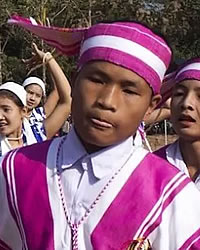Karen, Banlon Nge in Myanmar (Burma)

Photo Source:
Asia Harvest-Operation Myanmar
|
Send Joshua Project a map of this people group.
|
| People Name: | Karen, Banlon Nge |
| Country: | Myanmar (Burma) |
| 10/40 Window: | Yes |
| Population: | 4,600 |
| World Population: | 4,600 |
| Primary Language: | Language unknown |
| Primary Religion: | Buddhism |
| Christian Adherents: | 0.00 % |
| Evangelicals: | 0.00 % |
| Scripture: | Unspecified |
| Ministry Resources: | No |
| Jesus Film: | No |
| Audio Recordings: | No |
| People Cluster: | Karen |
| Affinity Bloc: | Tibetan-Himalayan Peoples |
| Progress Level: |
|
Identity
The Banlon Nge people are an ethno-linguistic group that were first visited by linguists in recent years, who determined their language is distinct from other Karen varieties in Myanmar. Pinlaung, the main center of the Banlon Nge Karen people, sits at an elevation of 4,950 feet (1,510 meters) above sea level, which gives some relief from the fiercely hot and humid climate of the plains. The town is mostly inhabited by Pa-O and Shan people.
Location: According to a researcher, 4,600 Banlon Nge Karen people inhabit 920 households in 13 villages1 scattered over a wide area in Pinlaung Township in the southern tip of Myanmar's Shan State. Before 2010, Pinlaung was virtually inaccessible to the outside world.2 Other villages spill across the state border into the western part of Pyinmana Township in the Naypyidaw Union Territory. Naypyidaw is unique in Myanmar as it is a newly constructed city outside of the control of any state or region, serving a similar purpose as Washington, D.C. in the United States. The Banlon Nge are the most widely dispersed of the four newly discovered “White Karen” groups profiled in this book.
Language: Unlike some of the other newly discovered “White Karen” languages, Banlon Nge Karen enjoys vigorous use in their communities and is not endangered. It is part of the Northern Karenic group of Tibeto-Burman languages, which includes the Lahta, Yinbaw, Yintale, Zayein, and Kayan.
History
Although the Myanmar government first classified this tribe as a Karen group in the 2014 Myanmar census, the people say they have identified themselves as Karen for generations.
Customs
The Banlon Nge, and the Banlon Gyi Karen, may have been the tribes referred to as Banyang or Banyok Karen in historical accounts. More than a century ago, girls were often married by the age of 13, but the rigid insistence on endogamy (that people must marry only within their clan) caused a visitor to observe in 1922 that the lack of available single people “quite often results in unions where husband and wife are of very unequal age, the husband 15, the wife 70, or the other way around….” The Banlon Nge Karen traditionally grew subsistence crops such as beans, maize, and cheroot leaves. In the 1990s, however, the opium trade expanded, and growing poppy became the major cash crop in the area. With incentives from the United Nations, many poppy plants have been replaced by coffee and tea in recent years. The climate has proved so favorable that Pinlaung quickly emerged as the premier tea-growing town in Myanmar.
Religion
Pinlaung has long been a Buddhist stronghold, with numerous famous temples, pagodas, and caves attracting visitors. The Banlon Nge Karen converted to Buddhism long ago due to the influence of their Pa-O and Shan neighbors. Today almost all of them are Buddhists, although their rituals contain many aspects of spirit worship. In 1911, a missionary who spent more than 40 years in Myanmar sounded this warning to Christians about the spiritual plight of groups like the Banlon Nge Karen: “If these tribes are to be won for Christ it must be within the next 25 years. At the end of that time all that are not Christians will have become Buddhists. If they become Christian the Buddhist dwellers of the plains will be encircled by a chain of Christians, whereas, if they become Buddhist, Burma will present a solid phalanx against Christianity.”
Christianity
Many Christians may be surprised to learn of Karen groups that are completely unreached by the Gospel, but the Banlon Nge Karen have no known followers of Christ in their midst. Other groups in the area are strong Buddhists, so it will probably require a concerted effort by Karen Christians who live hundreds of miles away to travel to Pinlaung and proclaim the Gospel to this evangelized tribe. No Scripture, video, or audio resources have ever been produced in the Banlon Nge Karen language.